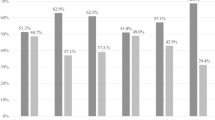Abstract
Bacterial vaginosis (BV), candidiasis, and trichomoniasis were the three established types of vaginal conditions until aerobic vaginitis (AV) was defined in the early 2000s. We sought to study the prevalence of abnormal vaginal flora (AVF) with inflammation in our hospital and to correlate it with AV. We prospectively collected vaginal smear specimens originated from symptomatic women who were examined at Iaso Obstetrics, Gynecology and Children’s Hospital of Athens from April 2014 until September 2015. Amsel’s criteria were used for the diagnosis of BV. The presence of leukocytes and lactobacillary grade were evaluated to classify a condition as AVF with inflammation; subsequently, bacterial cultures were performed. A total of 761 women were included. Five hundred and seventy-nine women were diagnosed with candidiasis, BV, trichomoniasis, or other types of vaginitis in which no pathogenic bacterial growth occurred in cultures. One hundred and eighty-two women (23.9 %) were diagnosed with AVF with inflammation (116 non-pregnant, 66 pregnant). Escherichia coli was the most common pathogen among these women (non-pregnant: 45.7 %, pregnant: 34.8 %). Other common pathogens were Group-B-Streptococcus (non-pregnant: 20.7 %, pregnant: 22.7 % respectively), Enterococcus faecalis (14.7 %, 18.2 %), and Klebsiella pneumoniae (6.9 %, 12.1 %). The prevalence of AVF with inflammation may be high. Since inflammation criteria were applied, most cases of BV were eliminated and the majority of cases of AVF are AV. Therefore, clinicians should include AV in the differential diagnosis of vaginitis, while microbiologists should take into account the growth of aerobic bacteria in vaginal cultures originating from women with microscopic findings of AV.
Similar content being viewed by others
References
Donders GG (1999) Microscopy of the bacterial flora on fresh vaginal smears. Infect Dis Obstet Gynecol 7:177–179
Donders GG, Bosmans E, Dekeersmaecker A et al (2000) Pathogenesis of abnormal vaginal bacterial flora. Am J Obstet Gynecol 182:872–878
Geng N, Wu W, Fan A et al (2015) Analysis of the risk factors for aerobic vaginitis: a case–control study. Gynecol Obstet Invest 81:148–154
Donders GG, Vereecken A, Bosmans E et al (2002) Definition of a type of abnormal vaginal flora that is distinct from bacterial vaginosis: aerobic vaginitis. BJOG 109:34–43
Donati L, Di Vico A, Nucci M et al (2010) Vaginal microbial flora and outcome of pregnancy. Arch Gynecol Obstet 281:589–600
Donders GG, Van Calsteren C, Bellen G et al (2010) Association between abnormal vaginal flora and cervical length as risk factors for preterm birth. Ultrasound Obstet Gynecol [Epub ahead of print]
Donders GG, Van Calsteren K, Bellen G et al (2009) Predictive value for preterm birth of abnormal vaginal flora, bacterial vaginosis and aerobic vaginitis during the first trimester of pregnancy. BJOG 116:1315–1324
Han C, Wu W, Fan A et al (2015) Diagnostic and therapeutic advancements for aerobic vaginitis. Arch Gynecol Obstet 291:251–257
Vieira-Baptista P, Lima-Silva J, Pinto C et al (2016) Bacterial vaginosis, aerobic vaginitis, vaginal inflammation and major Pap smear abnormalities. Eur J Clin Microbiol Infect Dis 35:657–664
Iavazzo C, Vogiatzi C, Falagas ME (2008) A retrospective analysis of isolates from patients with vaginitis in a private Greek obstetric/gynecological hospital (2003-2006). Med Sci Monit 14:CR228–CR231
Tansarli GS, Kostaras EK, Athanasiou S et al (2013) Prevalence and treatment of aerobic vaginitis among non-pregnant women: evaluation of the evidence for an underestimated clinical entity. Eur J Clin Microbiol Infect Dis 32:977–984
CLSI
Amsel R, Totten PA, Spiegel CA et al (1983) Nonspecific vaginitis. Diagnostic criteria and microbial and epidemiologic associations. Am J Med 74:14–22
Maniatis AN, Palermos J, Kantzanou M et al (1996) Streptococcus agalactiae: a vaginal pathogen? J Med Microbiol 44:199–202
Donders G, Bellen G, Rezeberga D (2011) Aerobic vaginitis in pregnancy. BJOG 118:1163–1170
Frobenius W, Bogdan C (2015) Diagnostic value of vaginal discharge, Wet mount and vaginal pH - an update on the basics of gynecologic infectiology. Geburtshilfe Frauenheilkd 75:355–366
Fan A, Yue Y, Geng N et al (2013) Aerobic vaginitis and mixed infections: comparison of clinical and laboratory findings. Arch Gynecol Obstet 287:329–335
Wang C, Han C, Geng N et al (2016) Efficacy of oral moxifloxacin for aerobic vaginitis. Eur J Clin Microbiol Infect Dis 35:95–101
Heczko PB, Tomusiak A, Adamski P et al (2015) Supplementation of standard antibiotic therapy with oral probiotics for bacterial vaginosis and aerobic vaginitis: a randomised, double-blind, placebo-controlled trial. BMC Womens Health 15:115
Donders GG, Ruban K, Bellen G (2015) Selecting anti-microbial treatment of aerobic vaginitis. Curr Infect Dis Rep 17:477
Author information
Authors and Affiliations
Corresponding author
Ethics declarations
Funding
None
Conflict of interest
None
Ethical approval
No
Informed consent
No informed consent was taken. The study was approved by the Scientific Committee of the Iaso Obstetrics, Gynecology and Children’s Hospital of Athens.
Rights and permissions
About this article
Cite this article
Tansarli, G.S., Skalidis, T., Legakis, N.J. et al. Abnormal vaginal flora in symptomatic non-pregnant and pregnant women in a Greek hospital: a prospective study. Eur J Clin Microbiol Infect Dis 36, 227–232 (2017). https://doi.org/10.1007/s10096-016-2787-5
Received:
Accepted:
Published:
Issue Date:
DOI: https://doi.org/10.1007/s10096-016-2787-5




